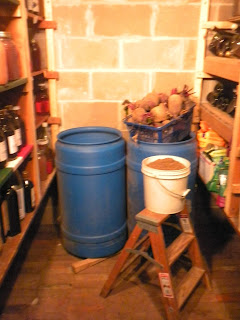 Field Notes. Wow! With grey skies and flurries, it feels like November is already here. Ken is busy with harvest of fall roots - they are beautiful this year. Last week he harvested potatoes - one the best crops ever. The fall cabbage are also solid nice looking heads.Those cool summer nights, late season rain, and late killing frost meant great crops.
Field Notes. Wow! With grey skies and flurries, it feels like November is already here. Ken is busy with harvest of fall roots - they are beautiful this year. Last week he harvested potatoes - one the best crops ever. The fall cabbage are also solid nice looking heads.Those cool summer nights, late season rain, and late killing frost meant great crops.Ken has been preparing seed and planting beds, planting green manures, and setting up late season hoopettes. He will be planting garlic and shallots and fall planted onion family next week.
Meanwhile I have sorted, boxed and gotten the potatoes into the root cellar, buried the carrots and beets in barrels of sand in the root cellar, and started the radishes. Next will be celery root and rutabagas. This winter we will try a couple new crops - stay tuned for details!
From the Kitchen. Since we have had cold night temperatures, we have been lighting the wood cook stove each morning. And since it has been dark in the morning, Ken has been cooking! He made a great combination of sweet and white scalloped potatoes - it was great! Peel sweet and white potatoes. slice onions, and then follow any scalloped potatoes recipe.
Ken also made a pumpkin pie. And an apple crisp.
What have I been doing? Juicing up various combinations of juices. And day to day cooking - midday roasts with roasted root vegetables, baked pork chops with onions and cabbage. Brown pork chops in an uncovered Dutch oven. Add sliced onions or leeks once you have turned the chops, and add thinly sliced cabbage and stock. Add herbs and or spices. One batch I used smoked paprika, chili pepper, and the other time I used savory and thyme. Bake at 200 degrees at least an hour - check to make sure there is adequate liquid to avoid scorching - add more stock if necessary; bake until the meat is tender. Serve with smashed boiled potatoes to absorb the cooking liquid, and a tossed salad.
'Til Next Week
Judith





















































